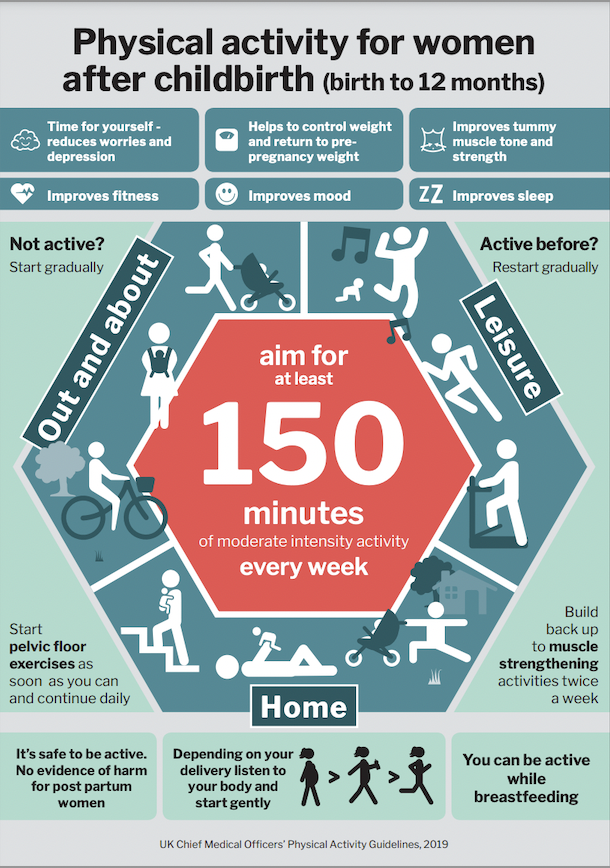Shape up after pregnancy
 Your body’s muscles will take time to recover following pregnancy and birth. To help you get back into shape there are some safe, easy and effective exercises that you can use.
Your body’s muscles will take time to recover following pregnancy and birth. To help you get back into shape there are some safe, easy and effective exercises that you can use.
This information has been produced by midwives and obstetric physiotherapists. It provides exercises that are suitable for everybody post-delivery, even if you have had a caesarean section.
The speed with which your muscles recover will depend on how well you feel and the type and amount of exercise you do. By actively working towards fitness you will feel better and may avoid future health problems. Please remember, it is important to start gently and progress slowly.

Toning up your stomach
You can start to tone up your stomach muscles as soon as you feel well enough.
Your stomach has two main muscle groups. It is important to strengthen the deep group of muscles first as this will reduce the strain on your back and pelvic floor.
Once these muscles are strong you can progress to the exercises which will strengthen your outer layer of muscles.
Following birth it is important you choose to exercise in a comfortable position, this may be sitting or lying down.
Deep Muscle exercises
- Let your tummy relax. Breathe in gently.
- As you breathe out, gently draw in the lower part of your stomach, squeezing your pelvic floor as well.
- Let go.
Don’t move your back at any time, you should be able to breathe and talk while you exercise.
Repeat this movement four or five times, with a few seconds rest between each one.
Aim to increase your muscle tone gradually, holding the muscles in for a maximum of ten seconds and repeating up to ten times.
After six weeks, ensure you can do these exercises while sitting and standing.
Tips for toning
Tips for toning
- It is very important to use the deep stomach and pelvic floor muscles in everyday activities. Hold them in when you are lifting and carrying or doing housework. This reduces the strain on your back and pelvic floor muscles.
- Don’t try any strong exercises such as sit-ups or lifting both legs when lying on your back as these may be harmful.
- Once you are comfortably achieving the deep stomach exercise, you can move on to the pelvic tilt.
Pelvic Tilt
- Lie at on your back with your knees in the air and perform the deep stomach exercise.
- Gently squeeze your pelvic floor and buttocks, tilt your pelvis up and flatten your back on the floor or bed.
Hold this position for a maximum of ten seconds, then release gently.
Tips for toning
Tips for toning
- Keep your stomach flat.
- If it bulges go back to the deep stomach exercise and try the pelvic tilt again in a few days time.
The head lift
The head lift
- Perform the pelvic tilt.
- Squeeze your pelvic floor muscles.
- Lift your head only, hold for a few seconds, then release gently and rest for a few seconds.
You should not perform the head lift if you notice your tummy muscle bulging or if you have neck pain.
To progress
Once you feel confident with the head lift, you can progress by:
- Prolonging the hold, up to a maximum of ten seconds. Keep breathing.
- Raising your head and shoulders.
It may take several weeks before you reach this stage, particularly if you have had a caesarean section. This is nothing to worry about.
Looking after your back
Looking after your back
It is important that you take care of your back after you have given birth.
Your back will be vulnerable for the first six months following delivery because increased hormone levels have weakened your stomach muscles and joints.
Always find a comfortable, well-supported position before carrying out everyday activities.
Remember to tighten your pelvic floor and deep stomach muscles whenever you are lifting. Use your legs, bend your knees and get close to whatever you are picking up. This will help protect your back and pelvic floor.
Exercising for life
Exercising for life
Many women choose to go back to sport two to three months after childbirth, but everyone is different.
Exercise should always be undertaken gradually, particularly if you aren’t used to it.
It is important to progress at a pace that suits you.
Click here to watch a useful video explaining some of the gentle exercises you can do.
Further advice
Further advice
If you require any further information or advice within the first ten days following birth please speak to your Midwife or GP who can advise you on local services.
You should also ask your GP for advice if you have any of the following problems:
- persistent pain in your back, pelvis, pubic bone, groin or stomach.
- a stomach that remains bulging and oppy more than six weeks after birth.
- any problems with loss of bladder or bowel control such as wetting, soiling or having to rush to the toilet.
- difficulties with sexual intercourse.
Remember - Don't forget to squeeze your pelvic floor muscles as you do the exercises
Remember
Don’t forget to squeeze your pelvic floor muscles as you do the exercises. Do not continue if you cannot stop your stomach bulging as you exercise, particularly if you had a caesarean section. Do not exercise if you feel tired or are unwell.
Your pelvic floor muscles form a sling from the front to the back to the pelvis and provide support to the organs within it. They also play a role in controlling your bladder, bowel and sexual functions.
Here is a useful video for you to watch that explains all about pelvic floor exercises.
The basic exercise
The basic exercise
Sit comfortably with your knees slightly apart and imagine that you are trying to stop yourself from passing urine or wind. The feeling is one of ‘squeeze and lift’ or a drawing together of the front and back passages. You should be able to feel the muscle move (a movement pulling away from your chair). Your legs and buttocks should not move and you should not hold your breath.
There are two variations of this basic exercise that you need to do to strengthen and improve the function of your pelvic floor muscles: slow and fast contractions.
Slow contractions
While sitting comfortably, tighten your pelvic floor muscles as hard as you can. Count to see how long you can hold this position for before the muscle starts to relax. Aim for a count of ten if possible.
How many seconds can you hold this position for?
Relax for a few seconds and then repeat this exercise as many times as you can (up to ten times). How many times can you repeat this exercise?
Fast contractions
Fast contractions
Sit comfortably with your knees slightly apart. Tighten your pelvic floor muscles as quickly as you can and let go straight away.
Count how many fast contractions you can do in a row before your muscles become too tired to continue. How many fast contractions can you do?
Your exercise prescription
Your exercise prescription
Each time you exercise you should perform:
slow contractions each one held for seconds (with a similar rest between each one).
Then you should perform fast contractions.
This exercise regime should be practised three times each day.
The knack technique
The knack technique
Tighten your pelvic floor muscle before and during these activities:
- coughing
- sneezing
- laughing
- picking something up
This is known as the ‘knack technique’ and can be used to reduce strain on your pelvic floor muscles and prevent leakage of urine.
Other things that may help
Other things that may help
- Maintain your optimum weight
- Avoid constipation
- Avoid heavy lifting
- Reduce your caffeine intake
How long will it take for the muscles to improve?
How long will it take for the muscles to improve?
If you do your exercises regularly you should see some improvement in three to six months. Some people may notice an improvement after six weeks.
Remember, pelvic floor muscle exercises are for life and your symptoms may return if you stop doing them. Training should become part of your daily routine.
Further information or advice
Further information or advice
If you require any further information or advice during your pregnancy, or following the birth of your baby, please contact your Midwife in the first 10 days or your GP or Health Visitor after this time.
You can also download a pelvic floor muscles exercise sheet by clicking here.



